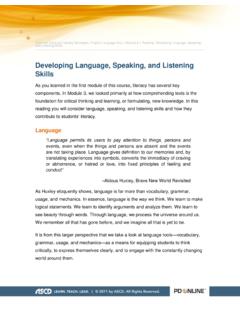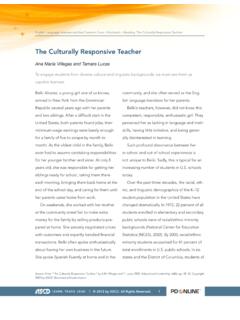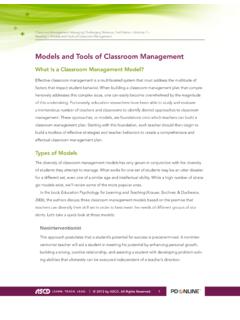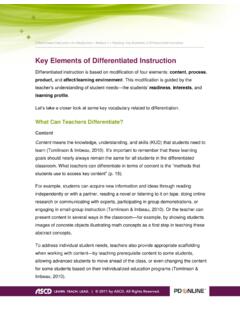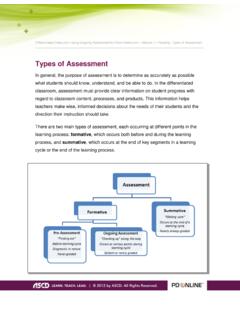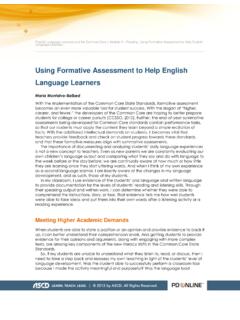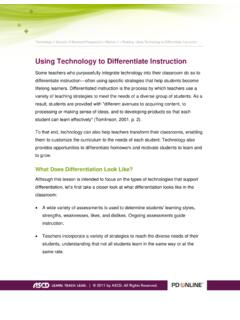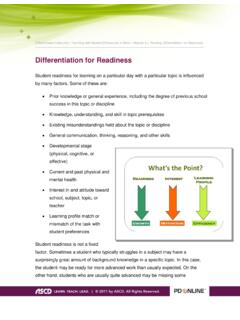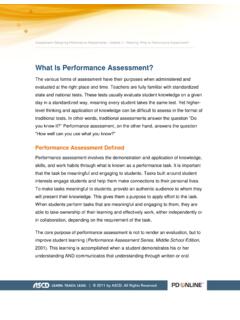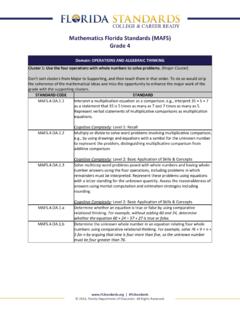Transcription of Unpacking Standards - ASCD
1 The Common Core Standards and the Understanding by Design Framework: English Language Arts > Module 2 > Reading: Unpacking Standards _____ Unpacking Standards Standards can be somewhat opaque, and they often vary in clarity, complexity, and specificity. Some Standards are broad, cutting across many courses and grade levels; others are narrow and content-specific. Some refer to content that must be taught; other Standards refer to performance levels that must be achieved. A standard has to be treated like any other nonfiction text; that is, we have to carefully analyze and interpret its meaning. A standard poses a challenge similar to the one posed by determining the meaning of the Bill of Rights in specific situations. In fact, a standard represents key principles that demand constant thought and discussion. That s what we mean by saying that educators need to unpack Standards for local use.
2 The practical meaning of a standard is not self-evident even if the writing is clear. Consider this example: Virginia History The student will understand the causes and effects of the Civil War with emphasis on slavery, states rights, leadership, settlement of the west, secession, and military events. [Source: VA Curriculum Framework United States History to 1865; Commonwealth of Virginia Board of Education Richmond, Virginia Approved July 17, 2008] Source: From The Understanding by Design Guide to Advanced Concepts in Creating and Reviewing Units (pp. 4 12), by G. Wiggins & J. McTighe, 2012, Alexandria, VA: ASCD. Copyright 2012 by Grant Wiggins and Jay McTighe. Reprinted with permission. The Common Core Standards and the Understanding by Design Framework: English Language Arts > Module 2 > Reading: Unpacking Standards _____ Stage 1 Desired Results Established Goals Common Core State Standards in Math Interpret the structure of expressions 1.
3 Interpret expressions that represent a quantity in terms of its context. Write expressions in equivalent forms to solve problems 3. Choose and produce an equivalent form of an expression to reveal and explain properties of the quantity represented by the expression. Rewrite rational expressions 6. Rewrite simple rational expressions in different forms. Mathematical Practices 1. Make sense of problems and persevere in solving them. 2. Reason abstractly and quantitatively. 3. Construct viable arguments and critique the reasoning of others. Transfer Students will be able to independently use their learning to .. Solve nonroutine problems by persevering: simplify them, interpret expressions, and use equivalent forms based on the properties of real numbers and the order of operations. Meaning UNDERSTANDINGS Students will understand that .. 1. In mathematics, we accept certain truths as necessary to permit us to solve problems with logical certainty ( , the properties of real numbers), whereas other rules are conventions that we assume just for effective communication.
4 2. We can use the commutative, associative, and distributive properties to turn complex and unfamiliar expressions into simpler and familiar ones when problem solving. ESSENTIAL QUESTIONS Students will keep considering .. 1. What important rules and conventions are required to make algebra work ? 2. How can we simplify this expression? Acquisition of Knowledge & Skill Students will know .. 1. The commutative property and to which operation it applies (and when it does not apply). 2. The associative property and to which operation it applies (and when it does not apply). 3. The distributive property and to which operation it applies (and when it does not apply). 4. The order of operations mathematicians use and why is it needed. 5. What PEMDAS mean. 6. What it means to simplify an expression via equivalent forms. Students will be skilled at .. 1. Writing expressions in equivalent forms. 2.
5 Revealing and explaining properties represented. 3. Rewriting rational expressions in different forms. 4. Identifying equivalence that results from properties and equivalence that is the result of computation. 5. Justifying steps in a simplification or computation by citing applicable laws, properties, conventions. Source: Goals from high school algebra Standards , pp. 63 65. Copyright 2011, National Governors Association Center for Best Practices and Council of Chief State School Officers. All rights reserved. What does understand mean here? Does it mean make meaning of and transfer? Or does it mean something narrower like analyze? Or is the demand far more modest, namely Accurately state and explain what others credible experts have analyzed the causes and effects to be, as found in textbooks (in other words understand = know )? As you can see, how we teach and how we assess this The Common Core Standards and the Understanding by Design Framework: English Language Arts > Module 2 > Reading: Unpacking Standards _____ standard is greatly affected by the outcome of our inquiry.
6 Such Unpacking is essential at the local level if the Standards are to be validly and consistently addressed across teachers, given the ambiguity of the key verb. Even if we agree on what understand means here, there is a second question that must still be considered: What is an adequate understanding for a 5th grader? In other words, how well must a student understand the causes and effects? How sophisticated should that understanding be, to be a fair expectation of a 5th grader? In other words, merely knowing the content to be addressed is not enough information for local action. We need to analyze all relevant text to infer a reasonable performance standard for assessing student work, that is, to know when student work related to the standard is or isn t meeting the standard. Structure and Organization of Standards Another reason for Unpacking has to do with the fact that Standards are typically written in a hierarchical outline form.
7 In many documents, the first level is the most broad and comprehensive statement, and the second and third levels are typically more concrete and narrowly focused. Each discrete element and outcome of learning is listed in an analytic fashion. Alas, as we well know from experience what seems like a good idea in theory a hierarchical list of key elements has an unfortunate common unintended consequence. Some educators think that Standards , arranged as organized in lists, need to be covered, one by one, in lessons and units. Not only is this practice unwise pedagogically; it is not the writers intent. Some Standards documents offer explicit cautions against such decontextualized teaching; for example: The Common Core Standards and the Understanding by Design Framework: English Language Arts > Module 2 > Reading: Unpacking Standards _____ Many of the objectives/benchmarks are interrelated rather than sequential, which means that objectives/benchmarks are not intended to be taught in the specific order in which they are presented.
8 Multiple objectives/benchmarks can and should be taught at the same time. [emphasis in the original] (Source: 2007 Mathematics Framework, Mississippi Department of Education, p. 8) Here is how the Common Core State Standards in English Language Arts are introduced: While the Standards delineate specific expectations in reading, writing, speaking, listening, and language, each standard need not be a separate focus for instruction and assessment. Often, several Standards can be addressed by a single rich task. (Source: Common Core State Standards for English Language Arts and Literacy in History/Social Studies, Science, and Technical Subjects, p. 5) Alas, this advice is routinely overlooked or ignored in local curriculum work. And yet the distinction between discrete elements and a more integrated curriculum plan is just common sense. A good meal is more than just the listed ingredients in the recipe; a successful home renovation doesn t merely involve contractors addressing each isolated piece of the building code; music is not made by learning hundreds of discrete notes, key signatures, and tempos in isolation from performance.
9 In fact, if transfer and meaning making are the goals of education, they can never be achieved by a curriculum that just marches through discrete content elements, no matter how sensible the hierarchical list is as an outline of a subject s high points. The Common Core Standards and the Understanding by Design Framework: English Language Arts > Module 2 > Reading: Unpacking Standards _____ Misconception Alert Standards documents are written in a hierarchical list format. This analytic framing of Standards can easily mislead teachers into the following misconceptions: The standard clearly expects me to teach and test each objective in isolation. I ll just focus on the top level ( , the broadest) standard. Then, I can justify most of what I already do as meeting the standard. I ll just focus on the lowest levels and check off these very specific objectives that are covered in my normal unit.
10 Then, I have addressed the standard. Each claim is inaccurate and leads to needlessly isolated and ineffective teaching and assessment. Different Goal Types in the Standards A third reason for Unpacking Standards results from the fact that Standards not only come in different shapes and sizes, but typically address different types of learning goals. It is not uncommon for a standard to mix together acquisition, meaning, and transfer goals in the same list without calling attention to the fact that each type of goal is different and likely requires different instructional and assessment treatments. Here is an example from the Common Core State Standards for 5th grade math: number and Operations in Base Ten Understand the place value system. 1. Recognize that in a multi - digit number , a digit in one place represents 10 times as much as it represents in the place to its right and 1/10 of what it represents in the place to its left.
